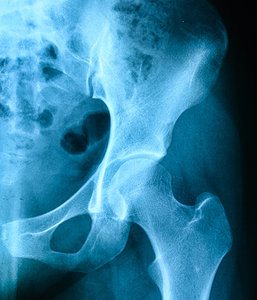The strength of chiropractic physical rehabilitation is first and foremost CMT, closely followed by our appreciation of a whole-body approach to balancing the entire kinetic chain. Thoughtful rehabilitation of the low back goes beyond handing a patient a sheet of exercises, regardless of whether it is based on McGill's approach of neutral spine or the flexion model of Williams, Hodge or Cox. (These were all discussed in the first three articles in this series.) Now, it is time to look at the relationship of the hip (acetabular joint) and pelvis (sacrum and ilium) in low back syndromes.
Restoring Normal LPH Complex Biomechanics: General Principles
Restoration of normal biomechanics in the lumbopelvic-hip (LPH) region involves addressing both the soft-tissue component (muscles, ligaments, tendons, joint capsules, etc.), as well as the joint component. A general rule of thumb in rehab progression is to restore proper joint motion first, then strengthen the region to reinforce proper biomechanics. Strengthening a region that is pathomechanical (either due to soft-tissue imbalances or loss of joint motion) will only perpetuate the underlying dysfunction.
Therefore, from a rehabilitative perspective the question becomes: Are the pathomechanics present from a loss of motion (a "mobility" issue) or from a loss of strength (a "stability" issue), and is the underlying cause poor soft-tissue compliance or joint dysfunction (subluxation)?
 This concept of mobility versus stability in physical rehabilitation is credited to Mike O'Boyle, who postulates certain regions of the body act as "stabilizers" while other regions are better adapted to "mobility." In his classification system, the lumbar region is a mobility area, whereas the hips / pelvis is considered a stability region.
This concept of mobility versus stability in physical rehabilitation is credited to Mike O'Boyle, who postulates certain regions of the body act as "stabilizers" while other regions are better adapted to "mobility." In his classification system, the lumbar region is a mobility area, whereas the hips / pelvis is considered a stability region.
In O'Boyle's paradigm, a common dysfunctional pattern found in clinical practice is for the mobility regions to become too mobile (hence requiring stability) and for the stability regions to lose motion (hence requiring mobility) to restore normal biomechanics. Therefore, in discussing the lumbar spine, the expected pattern is the pelvis and hips need more motion (CMT and soft-tissue work), whereas the lumbar spine requires stability and strengthening.
Just as active care is more than sending the patient home with a sheet of exercises, thoughtful CMT is more than a side-posture SIJ adjustment and a long-axis traction pull on the leg to adjust the hip. As DCs, it is essential that we own CMT of the hips and pelvis. Keep your skills sharp with postgraduate programs that emphasize hands-on techniques.
Assessment and treatment of the hips and SIJ in all planes of motion is beyond the scope of this article. The SIJ is complex in its biomechanics, having an upper and lower component with the sacral base being able to rotate both anteriorly and posteriorly on the ilium – nutation and counternutation, respectively.
Dynamically, in the gait cycle the ilium rotates around a frontal horizontal axis on the non-weight-bearing side, while on the weight-bearing side the ilium rotates around a vertical axis. Repetitive load, trauma, degenerative changes or maladaptive compensatory gait patterns can result in sacroiliac dysfunction. In addition, acquired hyper- or hypomobility of the SIJ results in altered load transmission, which further impacts the lumbar spine.
Functional Assessment
O'Boyle's contends the hip is a stability region; therefore, it tends to require extra attention to maintain mobility. Joint play of the hip in flexion, extension, long-axis extension, and internal and external rotation all need to be evaluated. Assessment of the LPH soft tissues for flexibility, strength, and tone via examination and functional movement screens completes the diagnostic algorithm.
The overhead squat test is a simple and well-referenced assessment tool for functional assessment of the LPH region.1 Performed in any treatment room, it can quickly screen for soft-tissue and joint imbalances that are contributing to the patient's pathomechanics. In just a few minutes, the length / tension relationship of the lumbar, core and lower extremity muscles can be attained.
Combined with an appropriate examination for joint and muscle function, you have the tools you need to rehab your patients. Other functional tests such as the dynamic Trendelenburg and Thomas's test also provide good information on LPH-region biomechanics.
A caveat in functional assessments: They are best done once the patient can perform the maneuvers pain-free. If pain is provoked while assessing a functional movement screen, it will skew the results as the body will favor the pain, not the dysfunction. Use functional assessments as a tool to guide active care.
Clinical Takeaway
The bottom line is to simply take the time to blend O'Boyle's concept into the active care of the lumbar spine by ensuring the LPH region is fully movable. Manual and instrument-assisted protocols work well for the soft tissues in this area; learn and apply them along with your CMT. As you restore mobility over the hip and SIJ, introduce stability exercises for the lumbar spine. Then reinforce proper biomechanics and functional movement patterns with strengthening exercises.
Author's Note: Upcoming articles in this series will outline the overhead squat assessment and active care principles for in-office use.
Resources
- Kritz M, Cronin J, Hume P. The body-weight squat: a movement screen for the squat pattern. J NSCA, Feb 2009;31:1, 76-84.
- Malagna G, Mautner K. Musculoskeletal Physical Examination, 2nd Edition. Philadelphia, PA: Elsevier, 2016.
- O'Boyle M. Functional Training for Sports. Human Kinetics, 2004.
Click here for more information about Donald DeFabio, DC, DACBSP, DABCO.





